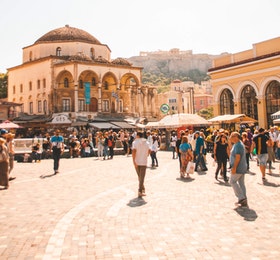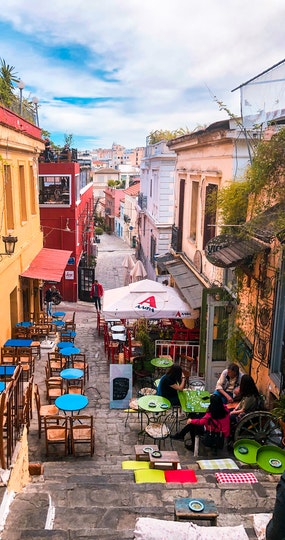Souda Bay War Cemetery
Suda Bay War Cemetery is a military cemetery designed by architect Luis De Soissons in which combatants of the First and Second World War are buried or commemorated. In particular, the cemetery site currently contains 1,500 graves of dead soldiers, 776 of which have not been identified, but special memorials commemorate a number of victims believed to be buried among them, 19 First World War burials, 7 burials of other nationalities and 37 non-war burials.
Archaeological Site of Ancient Aptera
Aptera, an ancient city of Crete, now ruined, is located in the region of Chania. There are ruins and remnants of civilizations with a history of over 2000 years. Within the archaeological site, you can see an ancient theatre, the ruins of several Doric temples, and a Roman peristyle villa. The most imposing monuments of the city are the drinking water tanks, which date back to the Roman period, but it is possible that the oldest ones were built during the Hellenistic period.
Firkas Fortress and Maritime Museum of Crete
The Firkas Fortress, which now houses the Maritime Museum of Crete, took its name from the Turkish word Firkas, which means division, as the fortress was the headquarters of the Turkish Division. One of the most glorious pages of modern Crete was written there, as on December 1st, 1913, the Prime Minister of Greece Eleftherios Venizelos and King Constantine, after seven centuries of slavery, raised the Greek flag on the fortress, sealing the union of autonomous Crete with the rest of Greece.
Chania Archaeological Museum
The Archaeological Museum was founded in 1963 and is housed in the church of St. Francis, a Venetian church, once the largest in Chania, which was also converted into a Mosque by the Ottomans. In this museum, you will have the opportunity to get to know the history of the island through the exhibits, which consist mainly of collections of sculptures, ceramics, gold jewelry, and coins.
Wander through the Old Port
The Old Port of Chania is perhaps one of the most beautiful spots in the city. It dates back to the 14th century, and in the surrounding area, there are many historical buildings, including arsenals from the Venetian era and an old mosque that now operates as an art gallery. The port is surrounded by a main road along the seafront, on which you will find many traditional taverns, cafes, and shops. One of the most popular areas of the city, it is bustling with life all year round, and in summer, it is flooded with tourists and locals enjoying the beautiful nighttime atmosphere it offers.
The Monasteries of Akrotiri Peninsula
Just a few kilometers from Chania is the Akrotiri peninsula. In this rocky area, there are three of the most important monasteries on the island. The monastery of Agia Triada, founded in 1612, is one of the richest and most beautiful monasteries of Crete, with unique beauty, among blooming and well-tended gardens with oranges and olives from which the monks make pure virgin olive oil that you can purchase. Every corner of this monastery is a work of art, and everyone who has visited it describes it as breathtaking.
A little further on, hidden in the wild but charming landscape of olive groves and rocks, is the historic Monastery of Gouverneto. Looking at it, one thinks it is a Venetian castle with its proud towers completing the spectacle.
Following a rough path on the north, the road leads to a wild and imposing gorge, Avlaki. There, hidden in the mountains, is the oldest Monastery of Crete, the Proskinima of St. John the Hermit or Xenos. The Monastery was built at the end of the 16th century, next to the cave where the Saint lived and died.
The Battle of Crete Historical Tour-German Military Cemetery from Chania
During World War II, many German soldiers died in Crete, with the number estimated to be over 15,000. In Maleme village, at Heigh Hill 107, there is one of the two cemeteries where German soldiers are buried in Greek territory. The spot chosen is not accidental, as it is a location of great strategic importance. When the Germans managed to occupy this area, they conquered the entire island of Crete.
Tradition
Fotokollyva
On the eve of the Day of Lights, an old tradition was for housewives to make 'photokoliva', a mixture of boiled wheat with pulses, which they and the whole family ate, but they also fed it to their animals for health and good luck in the family home.
Karakatzolia
A belief of Cretans is that children born on Christmas Day, and therefore conceived on the day of the Annunciation, carry a sin on them, because during the fasting period sexual intercourse is forbidden in the Orthodox Church. Thus, tradition says that on Christmas Eve children are transformed into elves and become human again on the day of the holy water, which expels all evil from nature.
Sheep Shearing
Every June in Crete the Feast of the Sheep is celebrated. During this day, all the farmers of the island invite their friends and relatives to help them shear their sheep. Once they are done with this arduous work, the sheep farmer organizes a feast with plenty of food and drinks to show his gratitude and appreciation.
The blessing of the sheep
On the day of St. George, the farmers bring their sheep to the village church and asking the blessing of the priest. Once the priest has blessed the sheep, the farmers milk them in the church's courtyard and share the milk with the people who gathered. After this ceremony, a big feast follows in the village square, for which even tourist excursions are planned.




